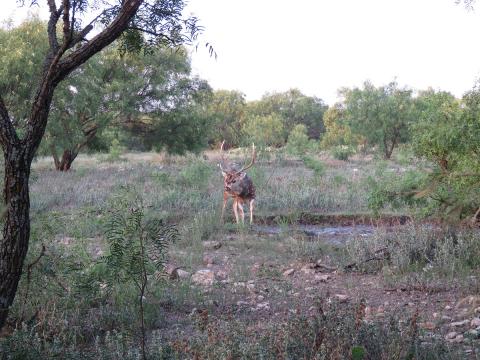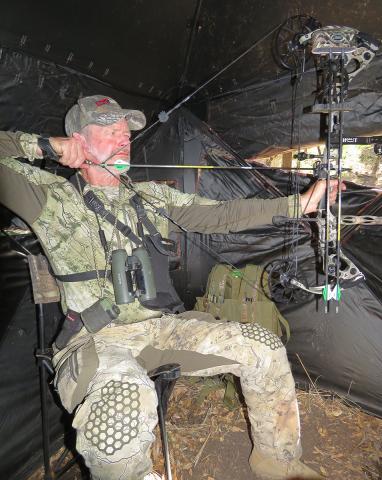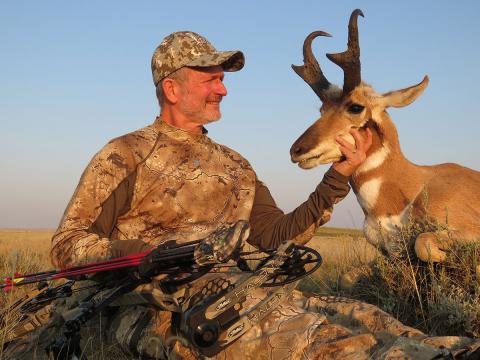Portable ground blinds have changed the face of bowhunting. Here’s how to maximize their effectiveness.
As a fledgling bowhunter growing up out West in the late 1970’s, spot and stalk hunting was the only way I knew how to try and get close enough for a shot. After many fruitless attempts and given the limitations of the equipment of the day, I quickly figured that setting an ambush would up my odds. That meant building little brush blinds near water holes and food sources or along well-worn game trails. Next came tree stands, more precisely the old Baker climber that was known as the “Death Trap” for good reason — it was famous for coming loose and sending the user crashing to the ground with no warning. When that happened to me, I said, “No More!” and went back to building brush blinds. But as tree stand design and manufacture became more sophisticated and safe, bowhunters took to the trees in droves, forsaking ground blinds.
Then, in the mid-1980’s I went to Africa for the first time, and as bowhunting became legal in more and more countries quickly discovered that professional hunters built lots of blinds near waterholes so archers could more easily get a controlled shot at spooky game. These blinds were serious affairs, large and roomy and comfortable and built to last. African PH’s had the advantage of being able to control access to the land they hunted and so such permanent structures could be designed and built to be used for years. I’ve shot several animals from ground blinds in southern Africa, everything from a leopard to a kudu bull and more.
I didn’t have that luxury back home being mostly a public land hunter. That’s why, when 20-some years ago the first portable ground blinds came out, I was fascinated. The earliest were a bit clunky, not all that durable and difficult to use. Today there are several different styles of ground blinds available on the market from chair blinds to hub-style ground blinds in a variety of sizes for up to four people. What type of ground blind you choose is going to weigh greatly on your intended use. If multiple hunters or a cameraman and hunter are going to share the ground blind, a ground blind with a larger footprint is the ticket.There are several different styles of ground blinds available, from one-person chair blinds with a built-in chair to hub-style ground blinds in a variety of sizes, for up to four people. The two most common types used by bowhunters are the spring steel type and hub style. The spring steel type has a system of poles that basically unfold at hinge points when setting up, then re-folds on itself when taking them down. Hub-style pop-up blinds use a system of hubs, bungee cords and graphite poles all cobbled together to allow these tent-like structures to be quickly and easily erected and taken down. Where spring steel ground blinds are the lightest, hub-style ground blinds offer the most durability and are a little more convenient to erect.
When I first started hunting from pop-up blinds I thought that smaller would be better, being easier to hide from game. Unlike gun hunters, bowhunters need a blind tall enough so they can draw their bow without the limbs hitting the roof, and wide enough so their elbow doesn’t hit the back wall at full draw and ensuring the arrow remains inside as well. I personally like blinds with a minimum footprint 60×60 inches square and at least 60 inches tall. (You shoot sitting down.)
Ground blinds come in all sorts of exterior camo patterns, but the interior should be solid black. This helps hunters remain in the dark for total concealment. Internally, blind companies incorporate all sorts of elastic hook closures, elastic curtain bands, zippers, magnets, Velcro and/or elastic cord slides together with material screens and adjustable window panels made of the same exterior material. Personally I despise Velcro-type closures since they are super noisy. A zippered corner back panel is the most common door style. Window design is especially critical for bowhunting. Basically, the larger and more adjustable the windows are, the better.
You’ll also need a chair that’s both comfortable for extended sits and that you can shoot out of. I’ve found that arm rests on the chair tend to get in the way when I try to draw and shoot, so I avoid them now. If I am setting up a blind for an extended period of time, a fully-adjustable swivel chair that weighs upwards of 20 pounds is super comfy. On short hunts or hunts where I am running and gunning and need extra portability, there are a number of small, lightweight folding chairs with a triangle seat that work great.
Little Things
When hunting turkeys, wild hogs and even bears, you’ll find the animals are not really bothered by a blind that is set up right before you hunt. Other big game, like deer, elk and similar critters can be quite nervous of a blind that’s just been set up. For that reason it’s important to erect the blind downwind of where you expect the animals to walk past and use brush, tree limbs, and other natural materials to “brush it in,” helping break up its outline. Some blinds have exterior fabric loops designed to hold brush and limbs, making this job easier.
When setting the blind up, in addition to wind direction it is important to set the blind either in the shade and/or where the rising and setting sun won’t shine in the front window, which will both impair your vision and light you up like a lamp. Whenever possible set the blind up against a tree line, in dense brush, near a hay bale, inside corn stalks or some other natural object that will help the blind to blend in. I only open windows enough that I can see a little bit to the sides and just enough in front so that I can make the shot when the time comes.
I like to bring a floor mat or old piece of carpet so my chair legs won’t sink into soft ground. I’ve tried hanging my bow from a hook attached to the blind’s roof poles, but find it’s so heavy it makes the poles sag and is difficult to quickly and quietly get down when game approaches. Now I use either a stake bow holder that can be driven into the ground, or lean the bow, with arrow nocked, upright against my daypack.
Since inside the blind you can’t feel the wind, I often hang a piece of light thread or dental floss (sometimes with a small downy feather attached) a few yards in front of my blind to so I can monitor subtle shifts in wind direction throughout my hunt.
Before/After Heading Afield
It’s super important to set up your blind in your garage well before you go hunting. There’s a trick to getting them set up, so putting a new blind up and taking it down several times will make it so much easier in the dark when you’re trying to be quiet.
When you get it set up at home, spray the blind’s exterior down with an anti-UV spray, which will help keep the camouflage fabric from deteriorating and fading. I also then spray mine with a water repellent spray and use Shoe Goop to fill in stitch holes and other hole where water might come in. Make certain everything is completely dried before folding the blind up for storage.
If you hunt in the rain, it’s important to set the blind up inside once you get home and let it dry thoroughly before storing it for a long period of time. This will inhibit mold and to keep all materials from deteriorating. If the zippers get mud in them, use water to clean them, then use unscented bar soap or a glycerin bar on the zipper teeth, which will enable them to glide smoothly and easily.
Unmatched Versatility
In the last decade I’ve arrowed a lot of animals from pop-up ground blinds, including pronghorn, elk, whitetail deer, mule deer, Coues deer, wild hogs, axis deer, coyotes, and I don’t know how many wild turkeys. My spring 2018 Nebraska turkey hunt illustrates the versatility.
I was hunting along the North Platte River following a blizzard that left ice chunks floating in the river and deep snow covering everything. The flock of birds was on a small mid-river island, and there was really no place to hide. After roosting them one evening my friend Kevin Howard and I donned chest waders and hauled a blind, decoys and our gear across the river, and set up where tracks were thick approaching the roost. We hunkered down for several hours comfortably out of the biting wind until we saw the birds approaching downstream. They slowly worked our way, and just before fly-up a big gobbler saw my Avian-X Jake and Breeding Hen decoy pair and strutted into range. It was a pleasure to pack him across the river.
It’s versatility like that that has me throwing a blind and chair into my truck pretty much every time I head out. You just never know.–Bob Robb



